Hydraulic Fracture Propagation in Fractured Rock Mass
Abstract
:1. Introduction
2. Crack Initiation and Propagation
2.1. Crack Initiation
2.2. Crack Propagation
2.3. Compression Shear Fracture Theory of Zhou Qunli
3. Analysis the Failure Type of Crag Bridge
3.1. Wing Crack-Wing Crack Failure Mode
3.2. Wing Crack-Shear Crack-Wing Crack Failure Mode
3.3. Wing Crack-Shear Crack Failure Mode
3.4. Shear Crack-Shear Crack Failure Mode
4. Conclusions
Author Contributions
Funding
Institutional Review Board Statement
Informed Consent Statement
Data Availability Statement
Conflicts of Interest
References
- Leonards, W. Modified hypothesis for failure of malpasset dam. Eng. Geol. 1987, 24, 367–394. [Google Scholar]
- Muller, L. The rock slide in the Vajont Valley. Eng. Geol. 1964, 2, 148–212. [Google Scholar]
- Tang, C.; Tham, L.; Lee, P.; Yang, H.; Li, L. Coupled analysis of flow, stress and damage (FSD) in rock failure. Int. J. Rock Mech. Min. Sci. 2002, 39, 477–489. [Google Scholar] [CrossRef]
- Tang, S.; Liu, X.; Luo, J.; Dong, Z. Theoretical model for tensile and shear crack initiation at the crack tip in rock subjected to hydraulic pressure. Chin. J. Rock Mech. Eng. 2017, 36, 2124–2135. [Google Scholar]
- Cao, P.; Liu, T.; Pu, C.; Lin, H. Crack propagation and coalescence of brittle rock-like specimens with pre-existing cracks in compression. Eng. Geol. 2015, 187, 113–121. [Google Scholar] [CrossRef]
- Li, B.; Zhu, Z.; Zhou, Z. A failure criterion for cracked rock mass under seepage pressure and confining pressure. Adv. Mater. Res. 2011, 225–226, 937–940. [Google Scholar] [CrossRef]
- Zhang, G.; Liao, X. Influence of seepage on the stability of rock slope-coupling of seepage and deformation by DDA method. Chin. J. Rock Mech. 2003, 22, 1269–1275. [Google Scholar]
- Jing, L.; Ma, Y.; Fang, Z. Modeling of fluid flow and solid deformation for fractured rocks with discontinuous deformation analysis (DDA)method. Int. J. Rock. Min. Sci. 2001, 38, 343–355. [Google Scholar] [CrossRef]
- Li, W.; Liu, Y.; Yao, X.; Chu, J.; Chen, X.; Tan, Z. Study on breakdown pressure in hydraulic fracturing process of hard rock based on numerical simulation. Geotech. Geol. Eng. 2021, 39, 909–917. [Google Scholar] [CrossRef]
- Yuan, Z.; Wang, H.; Liu, N. Numerical simulation of hydraulic fracture propagation characteristics of low permeable coal-rock mass. Adv. Mater. Res. 2012, 482–484, 1668–1671. [Google Scholar] [CrossRef]
- Liu, B. Experimental research of fine sandstone strength and deformation characteristics under different confining and hydraulic pressure. Appl. Mech. Mater. 2013, 353–356, 562–570. [Google Scholar] [CrossRef]
- Huang, W.; Wang, H.; Zhang, T.; He, M.; Yan, L. Hydraulic pressure effect on mechanical properties and permeabilities of layered rock mass: An experimental study. Eur. J. Environ. Civ. Eng. 2020, 1–12. [Google Scholar] [CrossRef]
- Wong, L.N.Y.; Einstein, H.H. Crack coalescence in molded gypsum and carrara marble: Part 1. macroscopic observations and interpretation. Rock Mech. Rock Eng. 2009, 42, 475–511. [Google Scholar] [CrossRef]
- Park, C.; Bobet, A. Crack initiation, propagation and coalescence from frictional flaws in uniaxial compression. Eng. Fract. Mech. 2010, 77, 2727–2748. [Google Scholar] [CrossRef]
- Yang, S.; Jing, H.; Wang, S. Experimental investigation on the strength, deformability, failure behavior and acoustic emission locations of red sandstone under triaxial compression. Rock Mech. Rock Eng. 2012, 45, 583–606. [Google Scholar] [CrossRef]
- Ashby, M.; Sammis, C. The damage mechanics of brittle solids in compression. Pure Appl. Geophys. 1990, 133, 489–521. [Google Scholar] [CrossRef]
- Yang, T.; Tham, L.; Tang, C.; Liang, Z.; Sui, Y. Influence of heterogeneity of mechanical properties on hydraulic fracturing in permeable rocks. Rock Mech. Rock Eng. 2004, 37, 251–275. [Google Scholar] [CrossRef]
- He, M.; Miao, J.; Feng, J. Rock burst process of limestone and its acoustic emission characteristics under true-triaxial unloading conditions. Int. J. Rock Mech. Min. Sci. 2010, 47, 286–298. [Google Scholar] [CrossRef]
- Li, X.; He, X.; Chen, H. Crack initiation characteristics of opening-mode crack embedded in rock-like material under seepage pressure. Chin. J. Rock Mech. Eng. 2012, 31, 1317–1324. [Google Scholar]
- Lajtai, E.; Carter, B.; Ayari, M. Criteria for brittle fracture in compression. Eng. Fract. Mech. 1990, 37, 59–74. [Google Scholar] [CrossRef]
- Liu, T.; Ping, C.; Hang, L. Evolution procedure of multiple rock cracks under seepage pressure. Math. Probl. Eng. 2013, 2013, 211–244. [Google Scholar] [CrossRef] [Green Version]
- Leung, K.; Pan, Z.; Warner, D. Kohn-Sham density functional theory prediction of fracture in silicon carbide under mixed mode loading. Model. Simul. Mater. Sci. Eng. 2016, 24, 35004. [Google Scholar] [CrossRef]
- Ilawe, N.; Zimmerman, J.; Wong, B. Breaking badly: Dft-d2 gives sizeable errors for tensile strengths in palladium-hydride solids. J. Chem. Theory Comput. 2015, 11, 5426–5435. [Google Scholar] [CrossRef]
- Zhao, X.; Cai, M.; Wang, J.; Ma, L. Damage stress and acoustic emission characteristics of the beishan granite. Int. J. Rock Mech. Min. Sci. 2013, 64, 258–269. [Google Scholar] [CrossRef]
- Guo, K.; Yang, L.; Sheng, X.; Mei, J.; Li, B.; Zhang, B.; Yang, W.; Song, G. Fracture mechanical behavior and AE characteristics of rock-like material containing 3-D crack under hydro-mechanical coupling. Chin. J. Rock Soil Mech. 2019, 40, 4380–4390. [Google Scholar]
- Zhao, Y.; Cao, P.; Lin, H.; Liu, Y. Rheologic fracture mechanism and failure criterion of rock cracks under compressive-shear load with seepage pressure. Chin. J. Geotech. Eng. 2008, 30, 511–517. [Google Scholar]
- Zhao, Y.; Cao, P.; Wen, Y.; Yang, H.; Li, J. Damage fracture failure mechanism of compressive-shear rock cracks under seepage pressure. J. Cent. South Univ. 2008, 39, 838–844. [Google Scholar]
- Jamaloei, B.Y. A critical review of common models in hydraulic-fracturing simulation: A practical guide for practitioners. Theor. Appl. Fract. Mech. 2021, 113, 102937. [Google Scholar] [CrossRef]
- Papachristos, E. A 3D Hydro-Mechanical Discrete Element Model for Hydraulic Fracturing in Naturally Fractured Rock; Grenoble Alpes University: Grenoble, France, 2017. [Google Scholar]
- Ai, D.; Jiang, G.; Lam, S.; He, P.; Li, C. Automatic pixel-wise detection of evolving cracks on rock surface in video data. Autom. Constr. 2020, 119, 103378. [Google Scholar] [CrossRef]
- Zhao, Y. Coupling Theory of and Seepage-Damage-Fracture in Fractured Rock Masses and Its Applications; Central South University: Changsha, China, 2009. [Google Scholar]
- Ashby, M.; Hallam, S. The failure of brittle solids containing small cracks under compressive stress states. Acta. Metall. 1986, 34, 497–510. [Google Scholar] [CrossRef]
- Zhang, Y.; Liu, Q.; Liu, H.; Liao, J.; Chang, L.; Tan, T.; Song, F. Triaxial compression and acoustic emission tests on single cracked limestone and compressive-shear fracture model under hydraulic-mechanical coupling action. Chin. J. Coal Sci. Eng. 2021, 46, 3855–3868. [Google Scholar]
- Liu, T.; Cao, P.; Zhao, Y. The damage fracture failure mechanism of compressive-shear rock cracks under high seepage pressure. Chin. J. Rock Mech. Eng. 2012, 33, 1801–1808. [Google Scholar]
- Liu, T.; Ping, C.; Hang, L. Damage and fracture evolution of hydraulic fracturing in compression-shear rock cracks. Theor. Appl. Frac. Mech. 2014, 74, 55–63. [Google Scholar] [CrossRef]
- Liu, T.; Cao, P.; Fan, X.; Zhao, Y. Splitting failure properties of fractured rock under high water pressure. J. Cent. South Univ. 2012, 43, 2281–2287. [Google Scholar]
- Liu, Q. Failure Characteristics of Single-Fracture Limestone Under Hydro Mechanical Coupling and Analysis of Insidious Fault Water Inrush; Hunan University of Science and Technology: Xiangtan, China, 2019. [Google Scholar]
- Zhou, Q. Compress shear fracture criterion of rock and it’s application. Chin. J. Geotech. Eng. 1987, 9, 33–37. [Google Scholar]
- Liu, T.; Cao, P. Failure mechanisms of brittle rock under uniaxial compression. J. Theor. Appl. Mech. 2017, 47, 59–80. [Google Scholar] [CrossRef] [Green Version]
- Cao, P.; Cao, R.; Zhao, Y.; Zhang, K.; Fan, W. Propagation-coalescence and rheologic fracture behavior of rock cracks. Chin. J. Nonferrous Met. 2016, 26, 1737–1762. [Google Scholar]
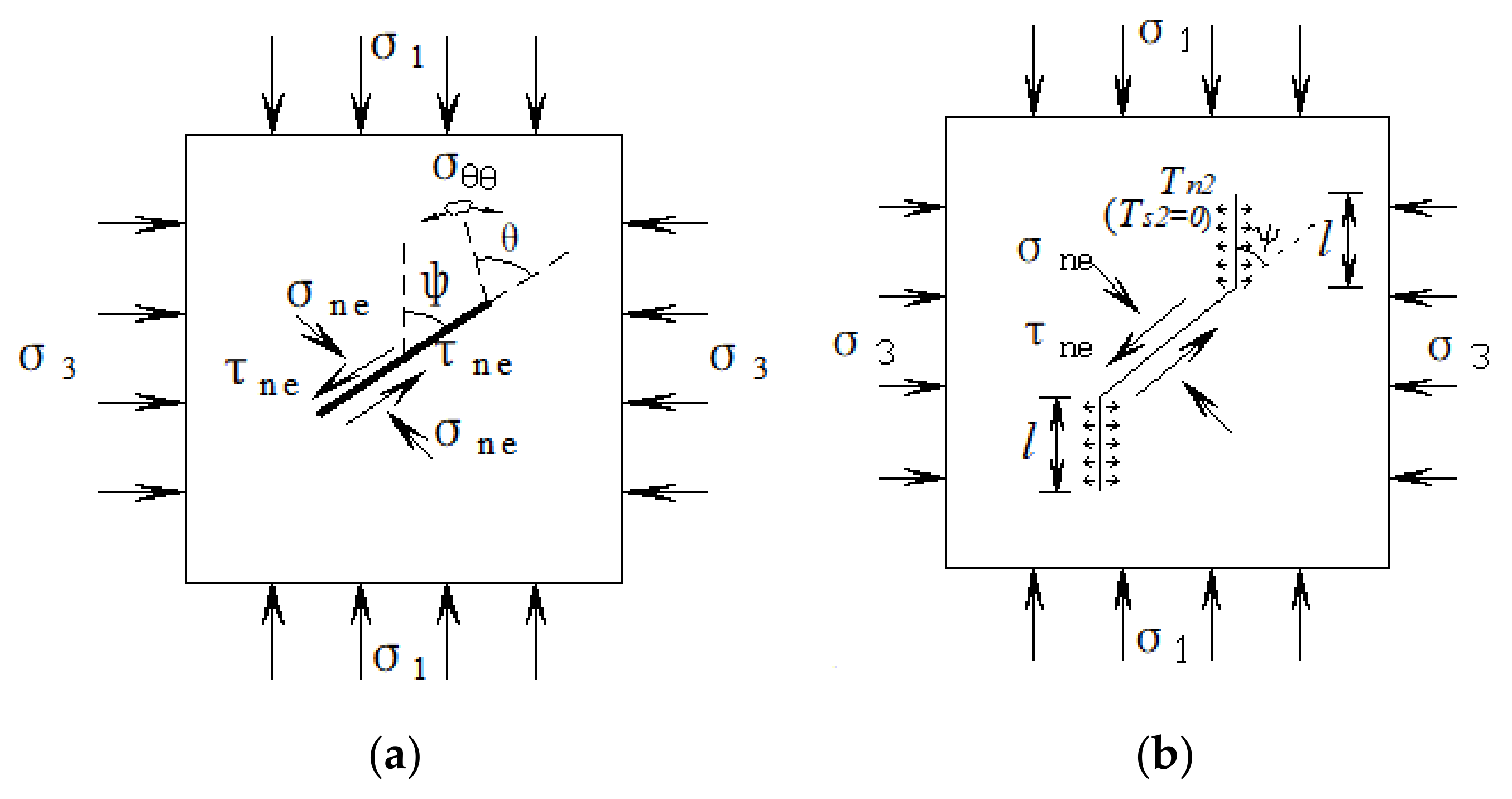
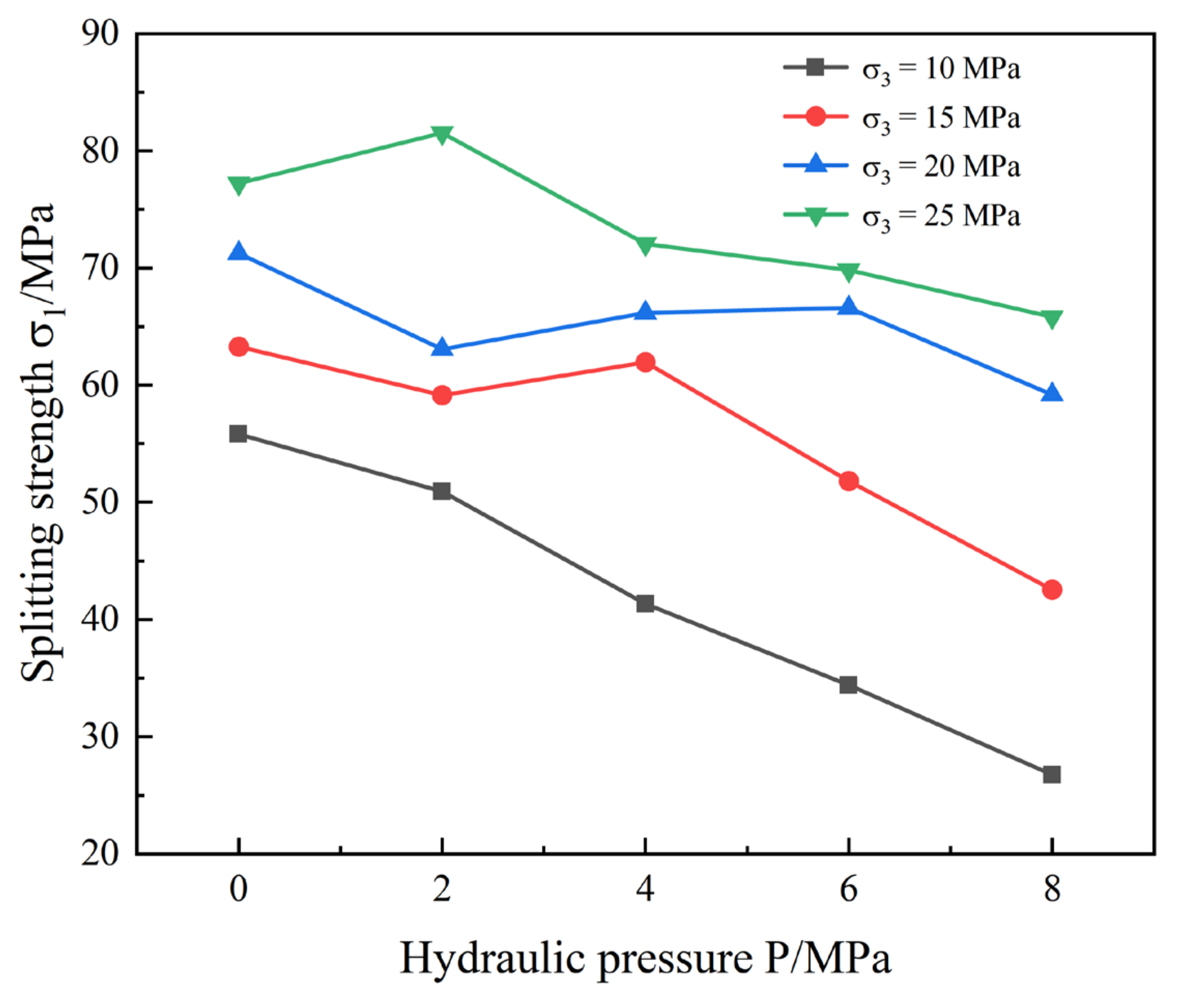

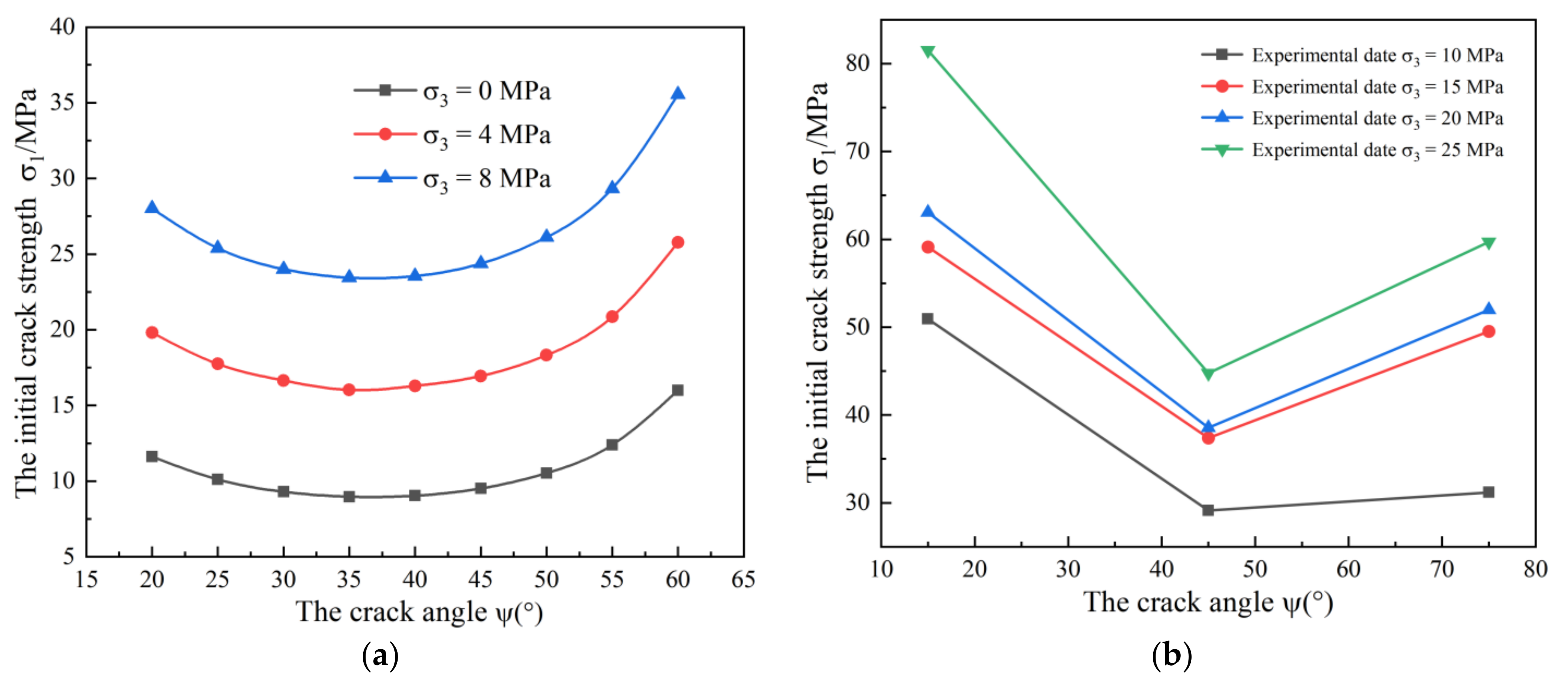
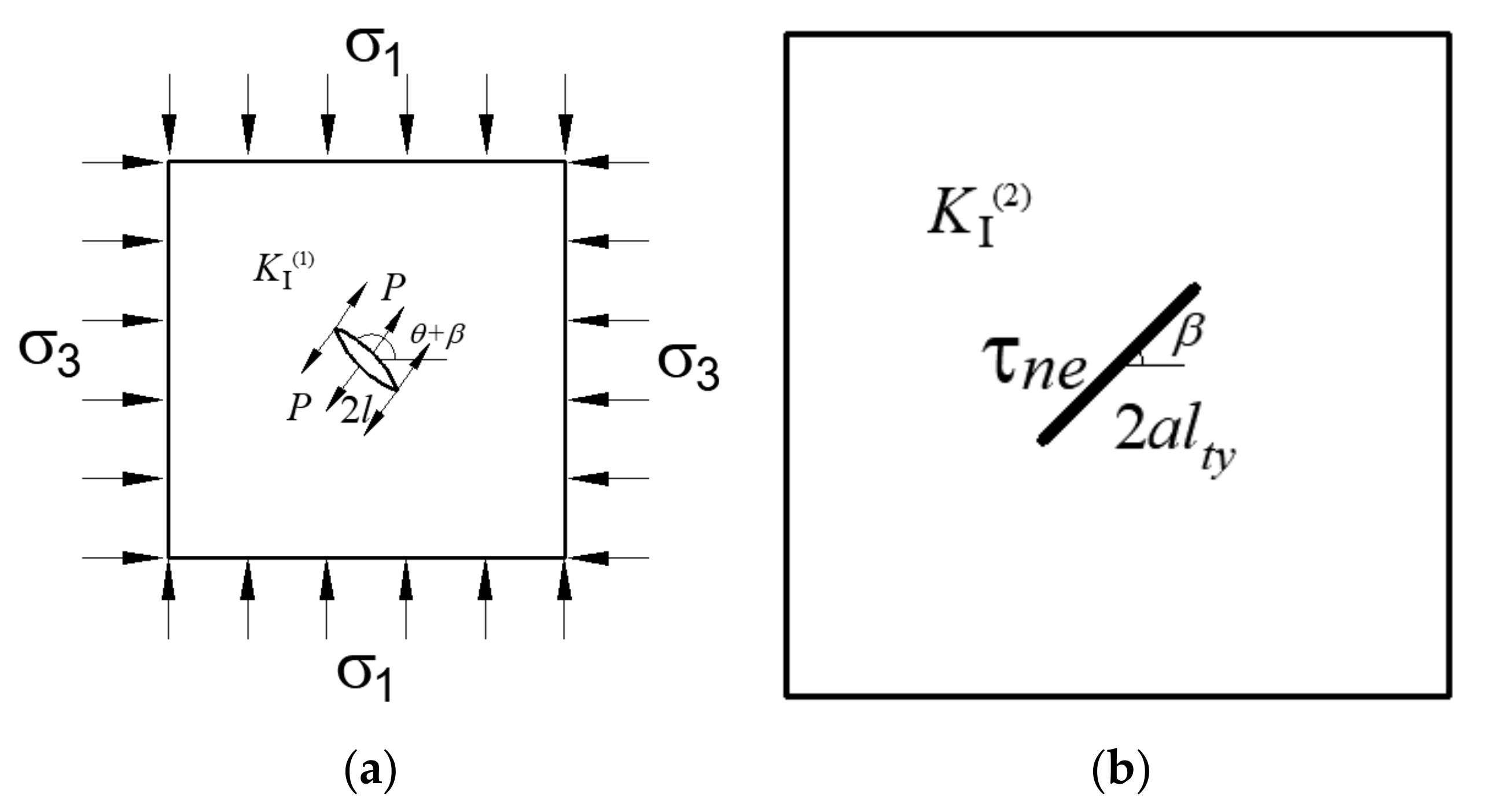

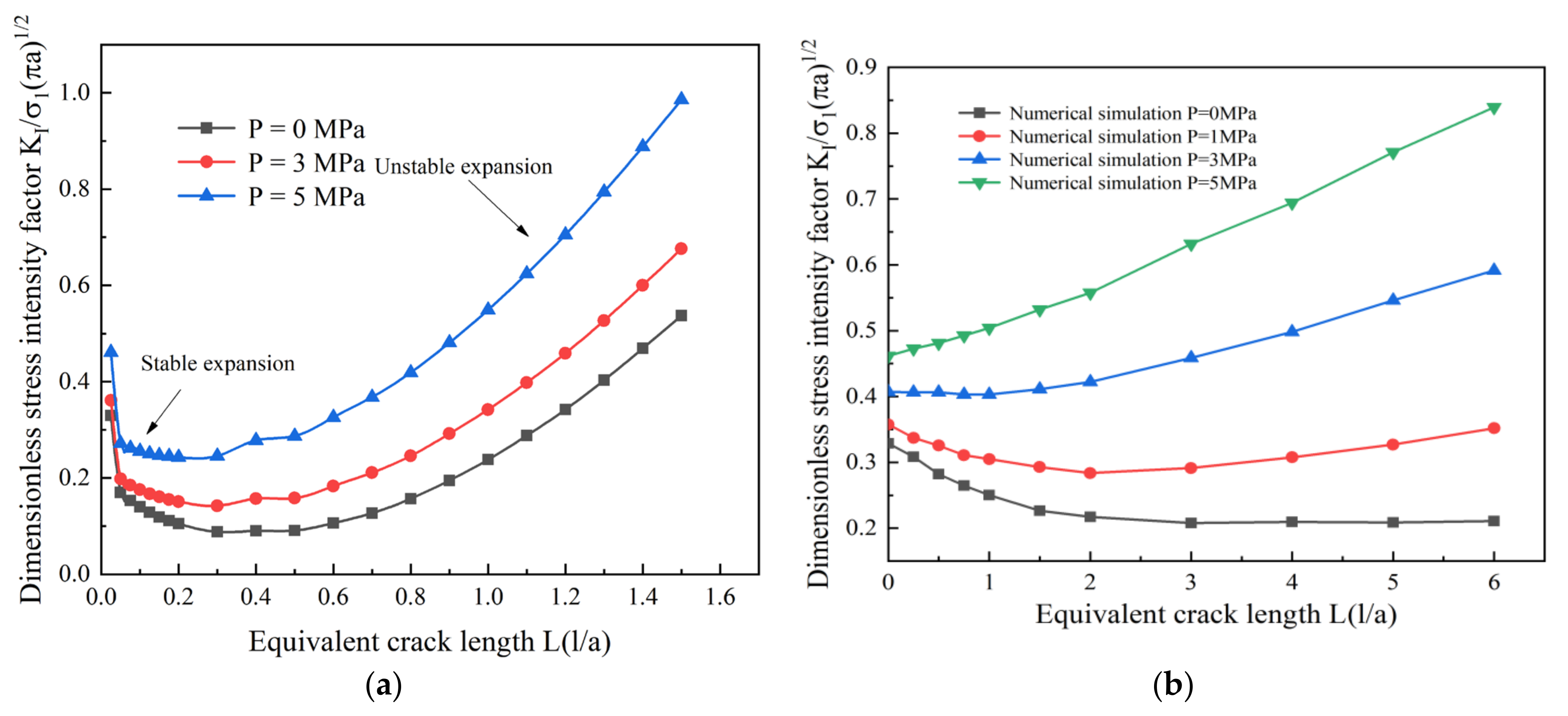

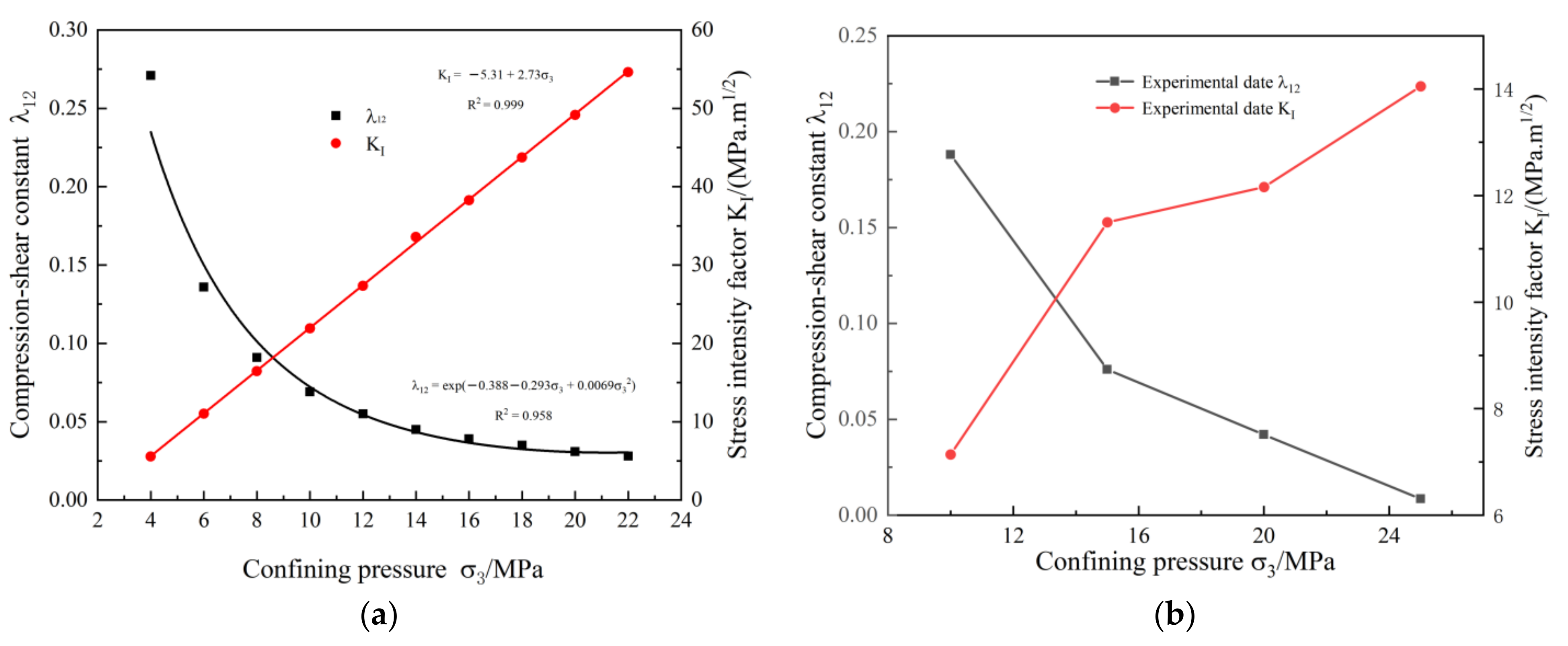

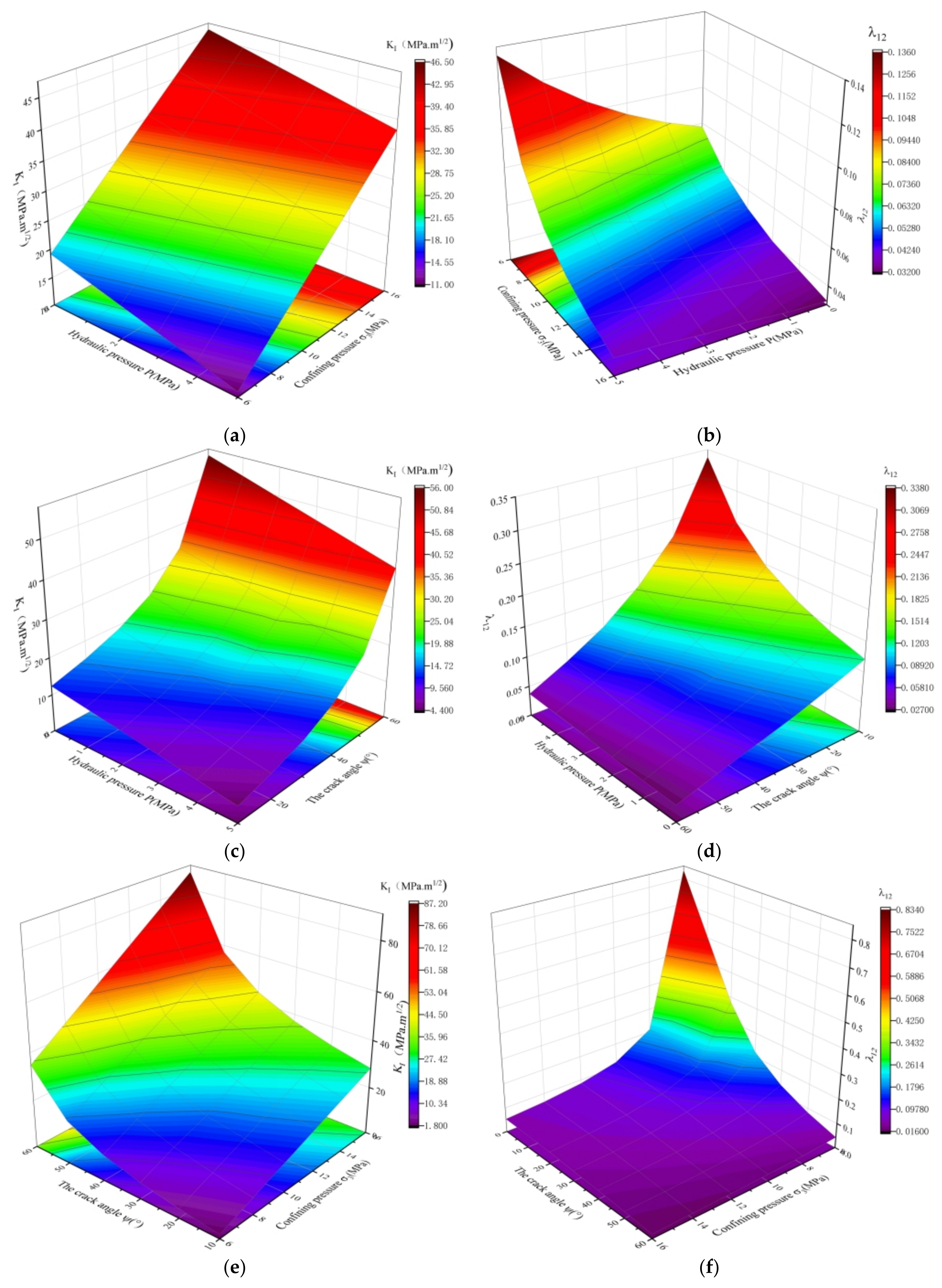
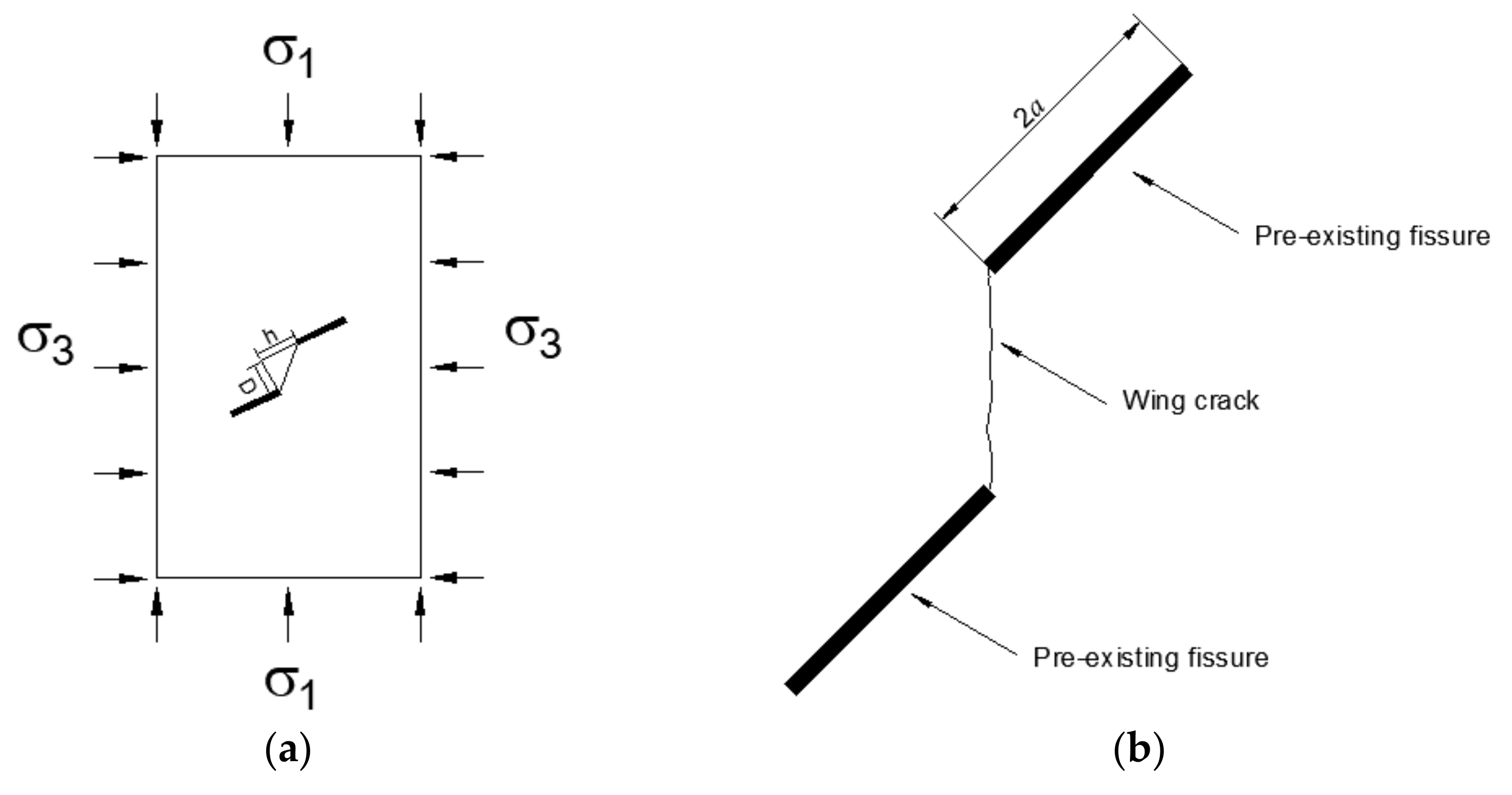
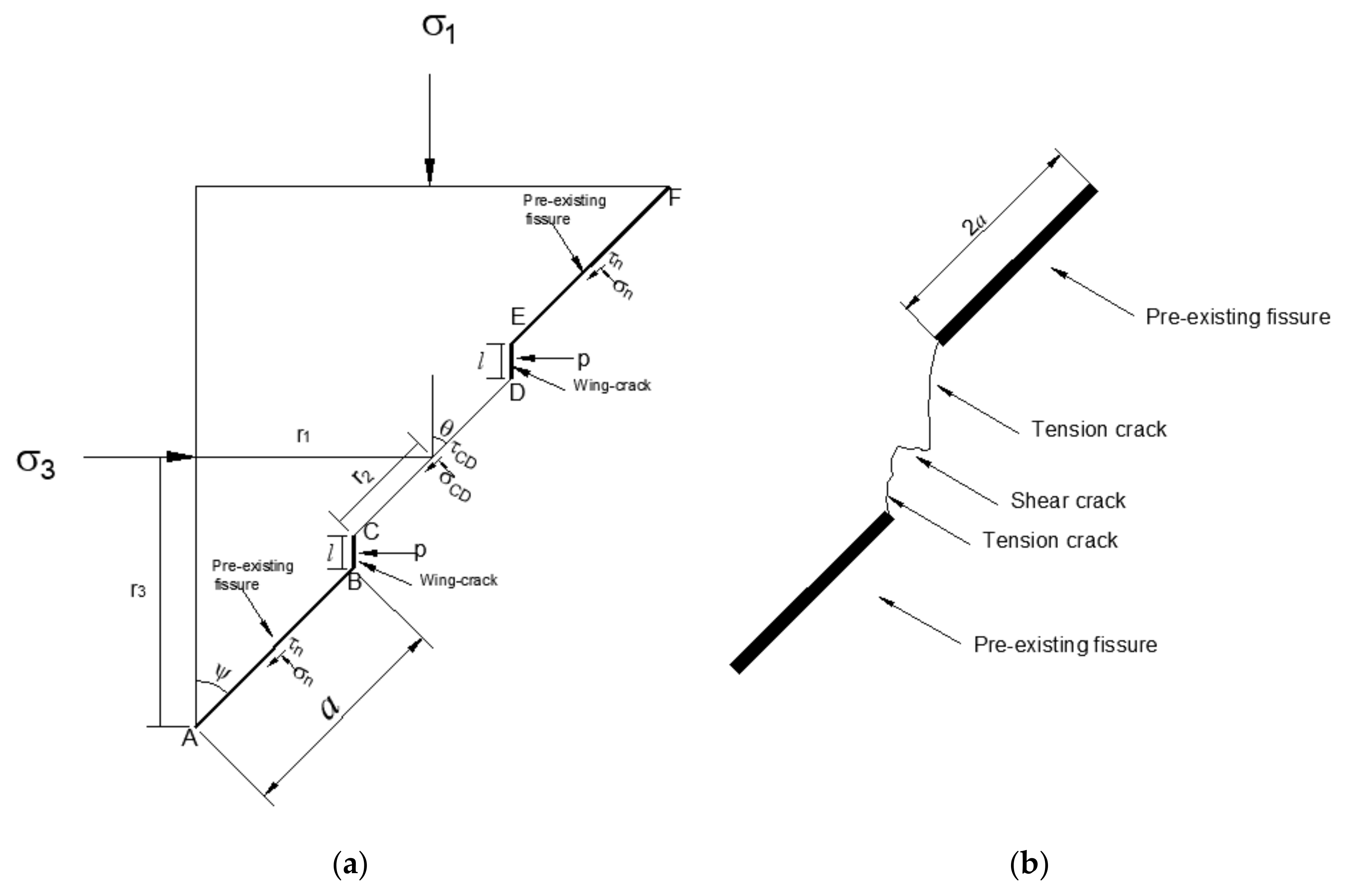
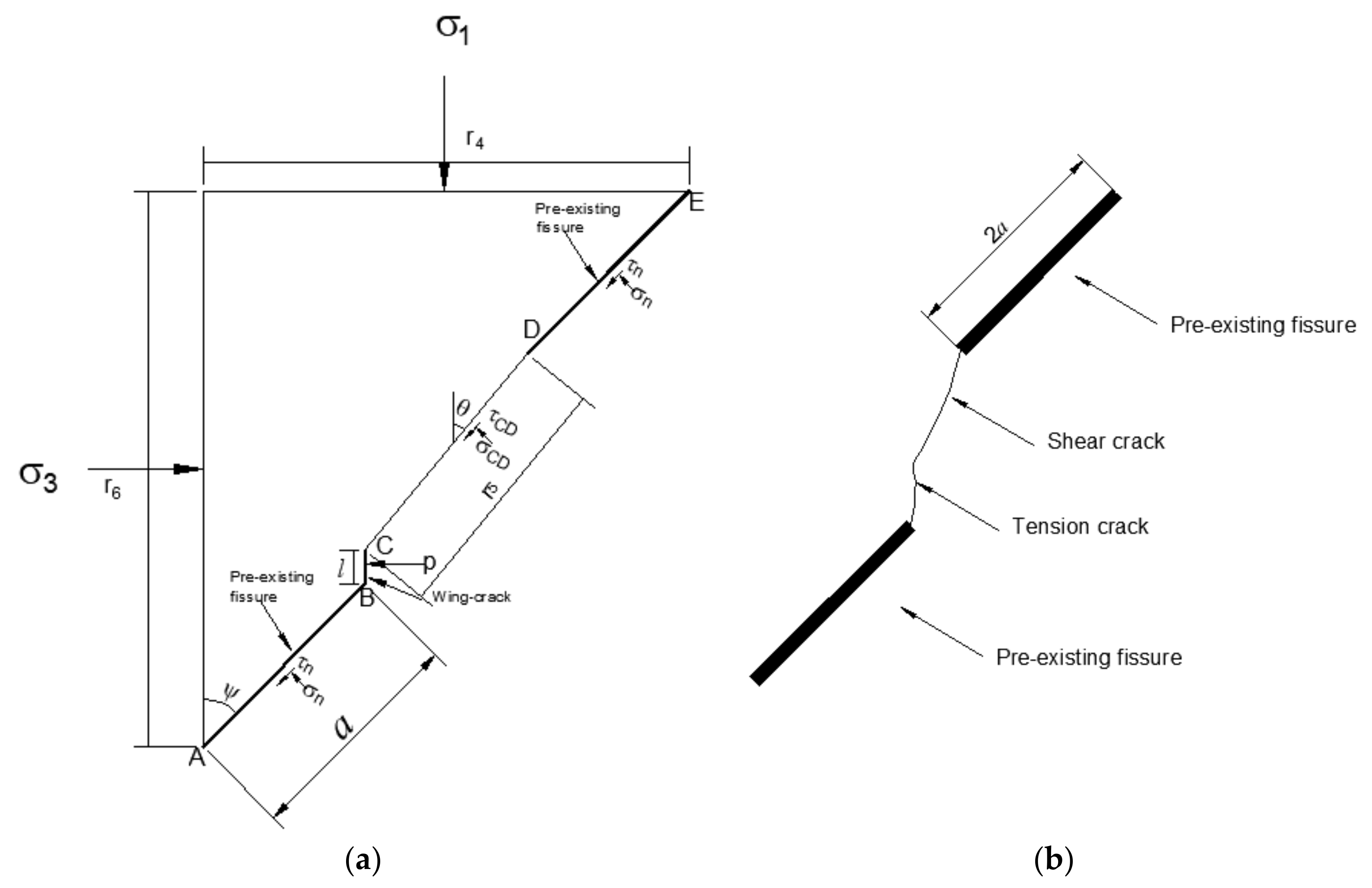
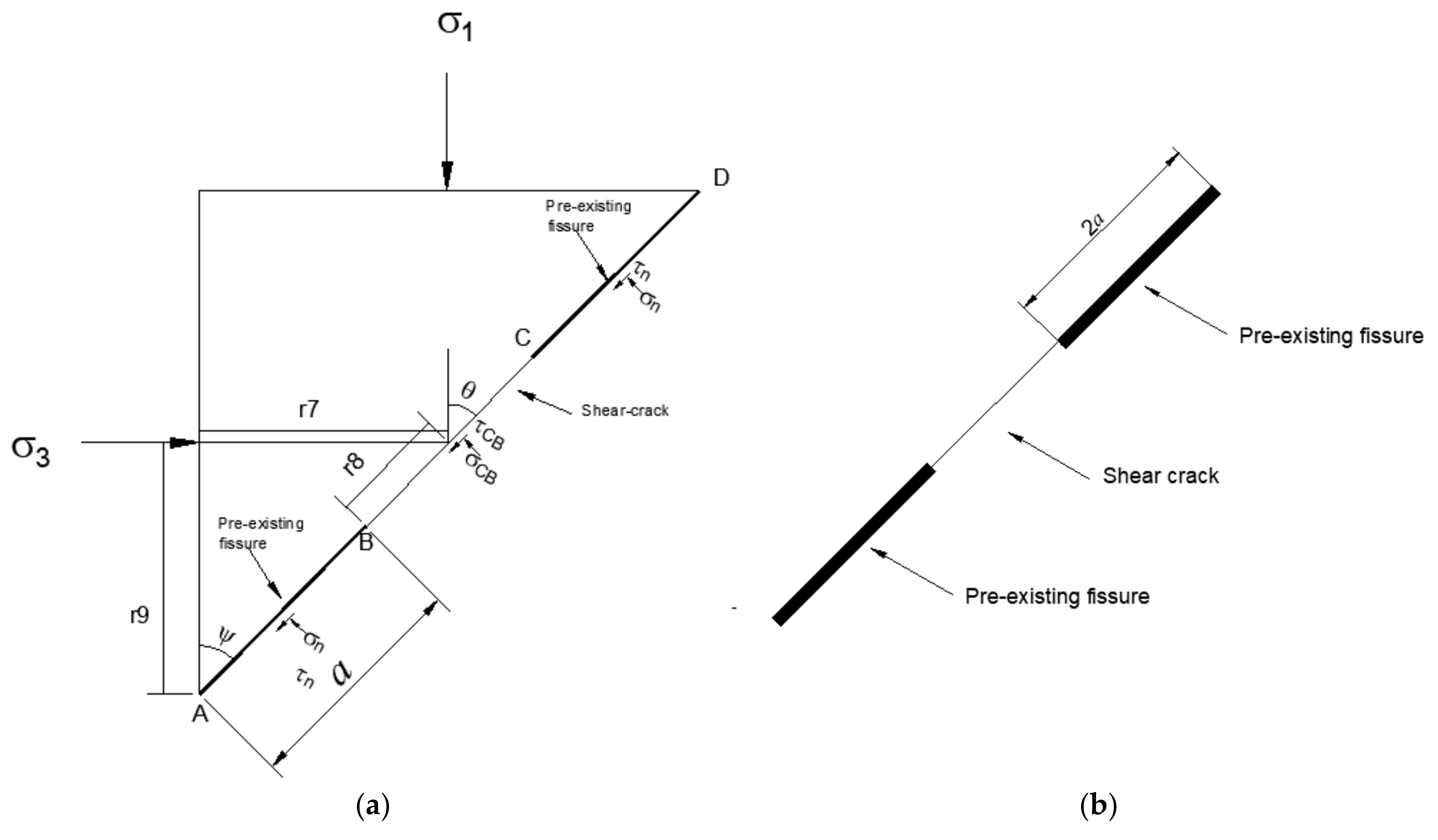
Publisher’s Note: MDPI stays neutral with regard to jurisdictional claims in published maps and institutional affiliations. |
© 2022 by the authors. Licensee MDPI, Basel, Switzerland. This article is an open access article distributed under the terms and conditions of the Creative Commons Attribution (CC BY) license (https://creativecommons.org/licenses/by/4.0/).
Share and Cite
Liu, T.; Sheng, Y.; Li, Q.; Zhang, C.; Cui, M.; Yu, Z.; Cao, P. Hydraulic Fracture Propagation in Fractured Rock Mass. Appl. Sci. 2022, 12, 5846. https://doi.org/10.3390/app12125846
Liu T, Sheng Y, Li Q, Zhang C, Cui M, Yu Z, Cao P. Hydraulic Fracture Propagation in Fractured Rock Mass. Applied Sciences. 2022; 12(12):5846. https://doi.org/10.3390/app12125846
Chicago/Turabian StyleLiu, Taoying, Yeshan Sheng, Qing Li, Chaoyang Zhang, Mengyuan Cui, Zhanfu Yu, and Ping Cao. 2022. "Hydraulic Fracture Propagation in Fractured Rock Mass" Applied Sciences 12, no. 12: 5846. https://doi.org/10.3390/app12125846
APA StyleLiu, T., Sheng, Y., Li, Q., Zhang, C., Cui, M., Yu, Z., & Cao, P. (2022). Hydraulic Fracture Propagation in Fractured Rock Mass. Applied Sciences, 12(12), 5846. https://doi.org/10.3390/app12125846




